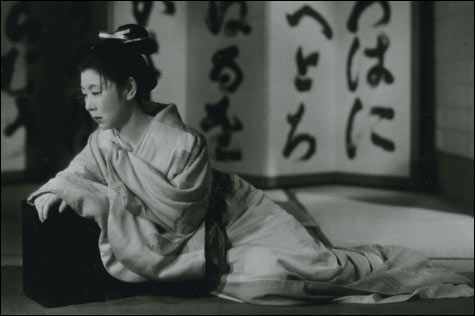The films of Kenji Mizoguchi at the MFA
By CHRIS FUJIWARA | December 27, 2006

LIFE OF OHARU: How much is love worth? |
Love is in question in all seven films to be screened at the Museum of Fine Arts in a touring mini-retrospective of the work of Kenji Mizoguchi. The odyssey of the heroine of LIFE OF OHARU (1952; January 14 at 12:40 pm) begins when she, a high-placed lady at court, is told by a retainer that he loves her. For submitting to this persistent suitor, she’s cast out of court and into a life of uncertainties and humiliations. How much is love worth in Life of Oharu? As much as in SISTERS OF GION (1936; January 5 at 6 pm), whose story is complementary. The heroine, an ambitious young geisha, is punished for acting as if she didn’t believe in love; Oharu is punished for acting as if she did.In THE STORY OF THE LAST CHRYSANTHEMUM (1939; January 11 at 2 pm and January 12 at 5:45 pm), love drives the heroine to sacrifice her health to help her lover achieve glory as a kabuki actor. UGETSU (1953; January 5 at 4 pm) explores eroticism and familial devotion through a tale of a ceramics maker and his family in a time when feudal wars terrorize the peasantry. In SANSHO THE BAILIFF (1954; January 6 at 10:30 am), a parable about the dawning of the consciousness of justice, love between a mother and her children endures across years of separation and oppression.
His examinations of love lead Mizoguchi to pose the most fundamental question of cinema: what is time? His films deal with several kinds of time: history, for one, which is time encapsulated and made readable as a movement that it’s up to the viewer to prolong beyond the screening of the film. Sisters of Gion, a dense, compact film of destinies pressed together, is nothing but a furious rush of time, breaking off with a famous scene that hands everything over to the viewer. Although the pace of The Story of the Last Chrysanthemum is less hurried, the film’s construction in end-to-end tracking shots suggests a similar conception of time to that of the earlier film. There are other kinds of time in Mizoguchi. Life of Oharu slips back and forth through time, suggesting that the heroine’s journey is an endless ride in an infernal amusement park. The gravestone toward which the camera rushes at the end of Ugetsu marks a stop to the movement of history, suggesting that time is not a relentless progress toward the future but that it leaves landmarks, toward which it must turn back again and again.
 Topics
Topics:
Features
, Entertainment, Science and Technology, Movies, More  , Entertainment, Science and Technology, Movies, Social and Behavioral Sciences, Sociology, Cultural Institutions and Parks, Museums, Museum of Fine Arts, Kenji Mizoguchi, Less
, Entertainment, Science and Technology, Movies, Social and Behavioral Sciences, Sociology, Cultural Institutions and Parks, Museums, Museum of Fine Arts, Kenji Mizoguchi, Less 